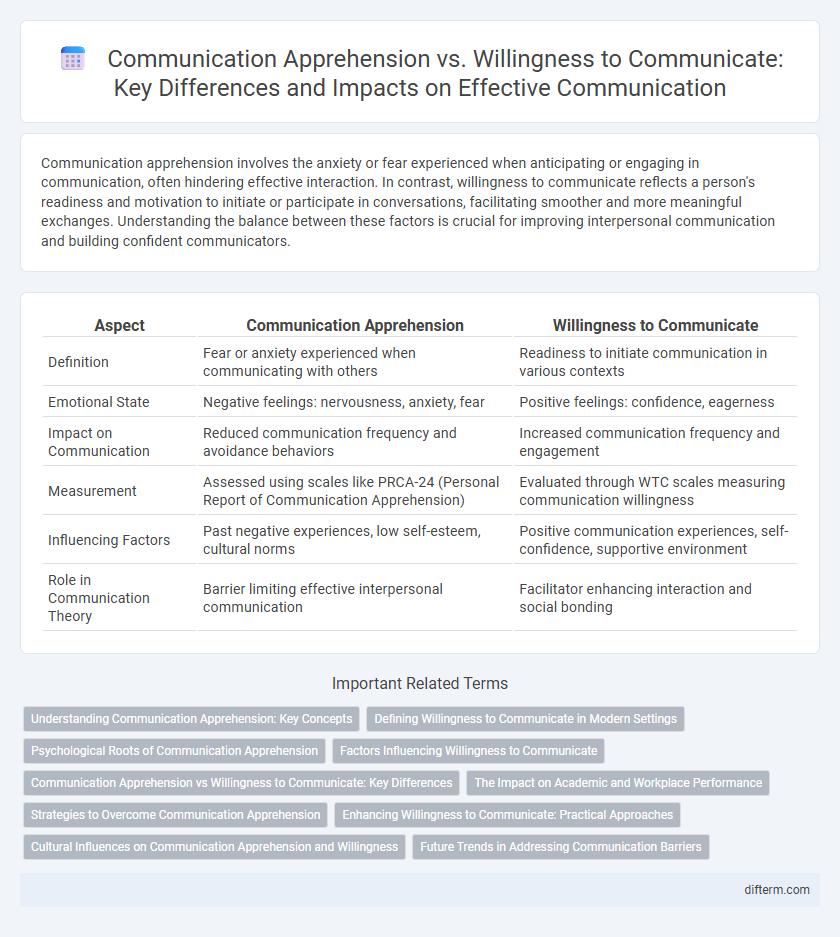Communication apprehension involves the anxiety or fear experienced when anticipating or engaging in communication, often hindering effective interaction. In contrast, willingness to communicate reflects a person's readiness and motivation to initiate or participate in conversations, facilitating smoother and more meaningful exchanges. Understanding the balance between these factors is crucial for improving interpersonal communication and building confident communicators.
Table of Comparison
| Aspect | Communication Apprehension | Willingness to Communicate |
|---|---|---|
| Definition | Fear or anxiety experienced when communicating with others | Readiness to initiate communication in various contexts |
| Emotional State | Negative feelings: nervousness, anxiety, fear | Positive feelings: confidence, eagerness |
| Impact on Communication | Reduced communication frequency and avoidance behaviors | Increased communication frequency and engagement |
| Measurement | Assessed using scales like PRCA-24 (Personal Report of Communication Apprehension) | Evaluated through WTC scales measuring communication willingness |
| Influencing Factors | Past negative experiences, low self-esteem, cultural norms | Positive communication experiences, self-confidence, supportive environment |
| Role in Communication Theory | Barrier limiting effective interpersonal communication | Facilitator enhancing interaction and social bonding |
Understanding Communication Apprehension: Key Concepts
Communication apprehension is the fear or anxiety associated with real or anticipated communication with others, often resulting in avoidance or reduced participation. Key concepts include trait apprehension, which is a consistent personality characteristic, and state apprehension, situational and transient in nature. Understanding these dimensions helps in identifying barriers to effective interaction and developing strategies to improve communication confidence.
Defining Willingness to Communicate in Modern Settings
Willingness to communicate (WTC) in modern settings refers to an individual's predisposition to initiate communication when given the opportunity, reflecting openness and motivation rather than mere ability. It is influenced by context-specific factors such as social anxiety, cultural norms, and technological platforms that affect interaction dynamics in digital and face-to-face environments. High WTC is associated with improved interpersonal relationships and effective information exchange in both personal and professional communication channels.
Psychological Roots of Communication Apprehension
Communication apprehension stems from psychological factors such as fear of negative evaluation, low self-esteem, and social anxiety, which inhibit an individual's ability to engage in conversations confidently. These deep-rooted anxieties generate avoidance behaviors and heightened physiological responses, influencing one's overall willingness to communicate. Understanding these psychological roots is crucial for developing effective strategies to reduce communication apprehension and foster greater communicative competence.
Factors Influencing Willingness to Communicate
Factors influencing willingness to communicate include individual personality traits such as extraversion and self-esteem, which enhance confidence in social interactions. Situational variables like the communication partner's familiarity, topic relevance, and perceived social support also play critical roles in increasing or decreasing one's willingness to engage in communication. Cultural background and previous communication experiences further shape individuals' readiness to participate actively in conversations.
Communication Apprehension vs Willingness to Communicate: Key Differences
Communication apprehension refers to the fear or anxiety individuals experience when anticipating or engaging in communication, often leading to avoidance or reduced participation in conversations. Willingness to communicate describes an individual's predisposition to initiate or participate actively in communication based on comfort and confidence levels. The key difference lies in that communication apprehension represents a motivational barrier due to fear, while willingness to communicate reflects an intentional readiness shaped by positive communication experiences and self-efficacy.
The Impact on Academic and Workplace Performance
Communication apprehension significantly hinders academic and workplace performance by reducing participation, collaboration, and information exchange, leading to lower productivity and learning outcomes. In contrast, a high willingness to communicate fosters active engagement, effective teamwork, and clearer understanding of tasks, enhancing both individual and organizational success. Studies reveal that addressing communication apprehension through training and supportive environments directly boosts confidence and performance in educational and professional settings.
Strategies to Overcome Communication Apprehension
Effective strategies to overcome communication apprehension include systematic desensitization, where individuals gradually expose themselves to communication situations to reduce anxiety, and cognitive restructuring, which targets negative thought patterns by fostering positive self-talk and realistic expectations. Skill-building through practice in low-stress environments enhances confidence, while seeking supportive feedback from peers or mentors encourages a positive communication mindset. Incorporating relaxation techniques like deep breathing and visualization further mitigates physiological symptoms of apprehension, promoting a greater willingness to communicate in diverse settings.
Enhancing Willingness to Communicate: Practical Approaches
Enhancing willingness to communicate involves creating supportive environments that reduce communication apprehension through positive reinforcement and skill-building activities. Techniques such as structured group discussions, role-playing, and personalized feedback help individuals build confidence and improve their communication competence. Integrating technology-based communication tools also offers low-risk platforms for practicing interaction, fostering gradual increase in willingness to engage in conversations.
Cultural Influences on Communication Apprehension and Willingness
Cultural values and norms significantly impact Communication Apprehension and Willingness to Communicate, as individuals from collectivist cultures often exhibit higher apprehension due to emphasis on group harmony and indirect communication styles. In contrast, those from individualist cultures tend to display greater willingness to communicate, encouraged by norms that value assertiveness and direct expression. Understanding these cultural influences is crucial for developing effective cross-cultural communication strategies and reducing apprehension in diverse settings.
Future Trends in Addressing Communication Barriers
Emerging technologies like AI-driven virtual reality and adaptive communication platforms are poised to reduce communication apprehension by creating immersive, low-pressure environments for practice and interaction. Future trends emphasize personalized communication training tools that leverage machine learning to identify and address individual anxiety triggers, enhancing willingness to communicate across diverse settings. Integration of biometric feedback and real-time sentiment analysis will further enable tailored interventions, promoting effective communication skills development and lowering apprehension barriers.
Communication Apprehension vs Willingness to Communicate Infographic

 difterm.com
difterm.com